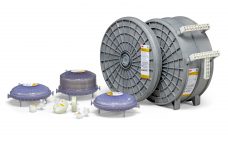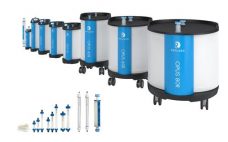This webcast is hosted by: Dr. Hani El-Sabbahy, Biopharmaceutical Application Engineering Specialist, Separation and Purification Sciences Division, 3M United Kingdom PLC 3M™ Emphaze™ AEX Hybrid Purifier is an all-synthetic clarifier consisting of a high capacity Q-functional hydrogel and a 0.2 ÎĽm polyamide membrane. The open structure and high charge capacity can handle turbid feeds, resulting in soluble and insoluble contaminant removal. Using data generated by sophisticated LC-MS/MS techniques, this webinar will explore the impact of deploying the Emphaze AEX Hybrid…
Ask the Experts
Packing Rigid POROS Chromatography Resins: Efficient and Fast Method to Get Optimal Results
This webcast features: Dr. Anna Le Bris, Senior Application Specialist, Bioproduction, Thermo Fisher Scientific POROS resins are widely used in commercial bioprocesses for the purification of large molecules, in both the capture and polish steps of downstream processing. POROS chromatography resins are based on a rigid polymer, allowing them to withstand very high pressure and be mechanically and chemically stable. Because POROS is a rigid bead, it can be packed in cGMP columns with volumes up to 1000 L. POROS…
Robust Performance of OPUS® Columns Pre-Packed with CHT™ Resin
This webcast features: Fletcher Malcom, Product Line Leader – Chromatography, Repligen Ceramic hydroxyapatite (CHT™) resins are used in processes where unique selectivity is desired for purification of mAbs or recombinant proteins. Until recently, shipping columns pre-packed with CHT™ resin provided challenges due to the fragile nature of the chromatographic bed. To overcome these challenges, Repligen has developed a proprietary packing method for CHT™ resins which maintains chromatographic performance during transit. In this presentation, packing performance and shipping validation data will…
Scalable Purification Strategies for Viral Vectors and Vaccines
This webcast features: Mark A. Snyder, Ph.D., R&D Manager, Process Chromatography Applications, Bio-Rad Laboratories Large-scale downstream processing of viruses can face a range of obstacles different from those of many biotherapeutics. These challenges mostly arise from the size and complexity of the virus, which can affect product purity and recovery. Improvements of purification tools are necessary to overcome these challenges and must be engineered for easy scalability to meet manufacturing demands. Dr. Mark Snyder will discuss the difficulties when developing…
The Impact of Rapid Virus Quantification in the Development and Manufacture of Advanced Therapies
This webcast features: Antje Schickert, Product Manager, Virus Analytics, Sartorius Stedim Biotech Viral vectors, such as lenti- and adeno-associated viruses, are increasingly being used for the production of cell and gene therapies. In-depth sample characterization and precise enumeration of total viral vectors is needed throughout the manufacturing process and particularly for the final formulation. Learn how rapid accurate enumeration of the total virus provides timely information on titer leading to accelerated process development and increased efficiency of viral vector manufacturing.…
Ask the Expert: A New AEX Mixed-Mode Chromatography Resin for High Selectivity and Recovery
In an Ask-the-Expert webinar on 16 May 2019, Xuemei He (R&D manager of chromatography media chemistry at Bio-Rad Laboratories, Inc.) introduced the Nuvia aPrime 4A mixed-mode chromatography resin. Its macroporous particles exhibit good pressure-flow properties in addition to optimal ligand density and hydrophobicity. So this versatile resin offers effective separation of target from impurities in both flow-through and bind–elute modes, with good recovery of target proteins under gentle purification condition. He’s Presentation The resin is a hydrophobic anion exchanger with positively…
Ask the Expert: The MYCAP CCX System: Expand Outside the Hood
Charles Meadows (product manager at Sartorius Stedim Biotech) joined BPI for an Ask-the-Expert webinar on 13 June 2019 featuring the MYCAP CCX cell culture expansion system. He showed how a closed aseptic cell expansion process can decrease the rate of batch failure from contamination, in turn reducing waste and overhead costs. Meadows’s Presentation Contamination is an inherent risk of open cell culture expansion systems. Each passage from one flask to the next potentially exposes cellular material. A recent BioPlan Associates…
Ask the Expert: Efficient Technology Transfer: A CDMO Perspective
Effective transfer of technology from a sponsor facility to a contract development and manufacturing organization (CDMO) is essential to rapid biomanufacturing, especially for early and late-stage clinical supply. But the process is not as simple as “plug and play.” In an Ask-the-Expert webinar on 25 June 2019, Roy Sevilla (senior manager of upstream process development at Avid Bioservices) explained how his company orchestrates transfer operations with cross-functional teams. Strong, frequent collaboration with process sponsors ultimately mitigates risks associated with scale-up,…
Ask the Expert: Developability: Evaluating Specificity, Immunogenicity, Functionality, and Manufacturability for Lead Candidate Selection
Campbell Bunce (chief scientific officer at Abzena) joined BPI for an Ask-the-Expert webinar on 21 May 2019 to discuss his company’s approach to developability assessment, an increasingly popular way to identify leading drug candidates. Bunce explained what developability assessment is and how Abzena uses it to identify candidate liabilities and manage both clinical and financial risk during key stages of drug development. Bunce’s Presentation The high attrition rate of drug candidates from discovery to clinical proof-of-concept is well known. The…
Ask the Expert: GMP Flow Cytometry: Applications, Considerations, and Challenges
On 31 July 2019 Jamie Hall (project manager at Intertek Pharmaceutical Services) joined BPI for an “Ask the Expert” webinar to explore key applications and considerations for implementing flow cytometry (FC) methods in a GMP environment. This increasingly important technique can be applied to all stages of drug development in a range of applications, including cell-line identification, immunophenotyping, and cell-based potency assays. In a regulatory environment, such flexibility can present challenges. Hall explained how scientists can approach FC method development…





